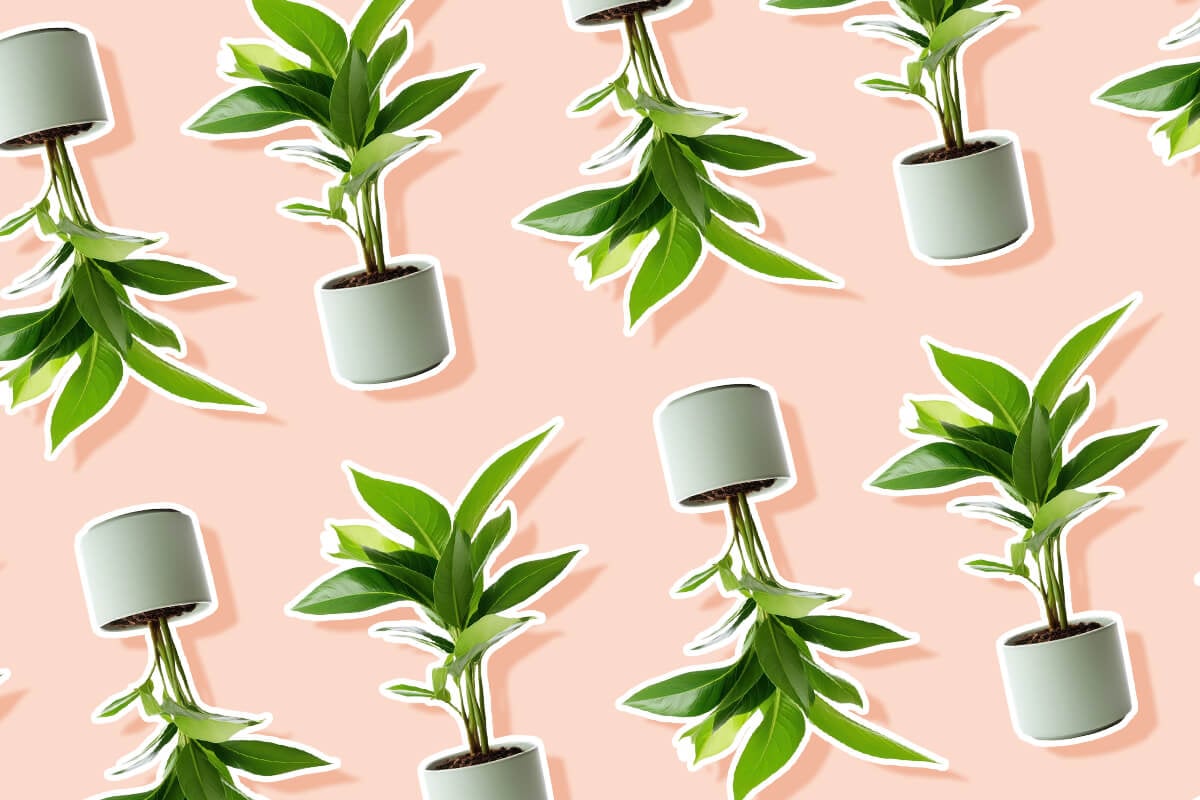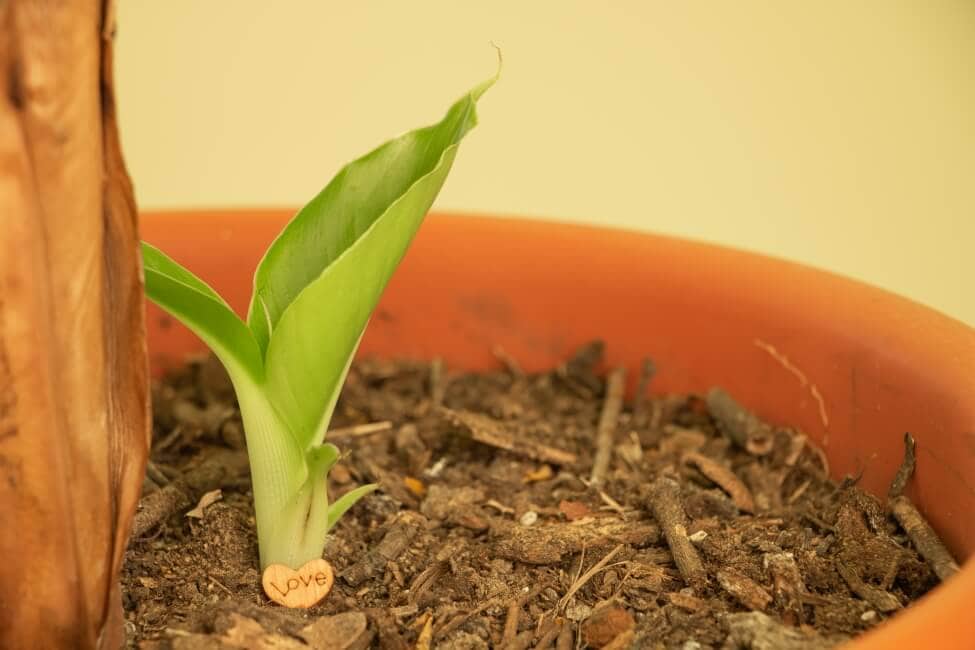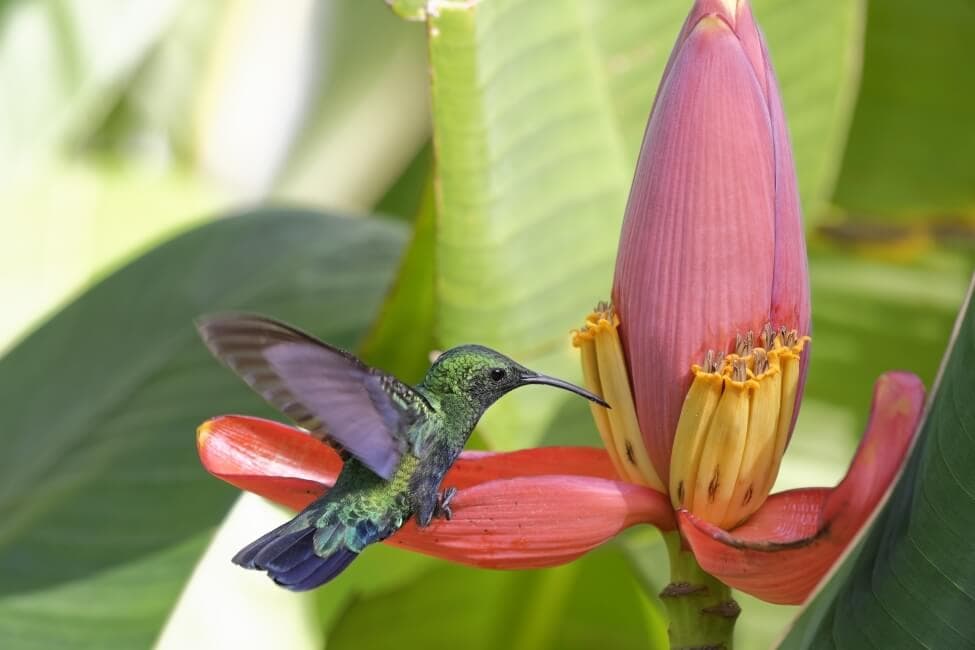Banana Plant Care at Home: Your Complete Guide
Chances are, almost everyone has eaten a banana at some point in their lives, but not everyone knows you can grow the tropical banana plant (Musa) indoors at home. While you shouldn’t expect your new houseplant to provide daily snacks, it will grace you with large, delicate leaves. With various cultivars available, you can find a plant that fits into a tiny corner or adds a bit of tropical drama to a room with high ceilings. If you choose a proper variety and provide the necessary environment, banana plant care at home can be an absolute joy.

How to Grow Banana Plants Indoors at Home

Growth Expectations
The maximum height of your banana plant will depend on the cultivar you select. Dwarf varieties top out at six feet, while some tallest types can grow over 20 feet tall.
Banana trees can grow quickly, with a new leaf emerging every few weeks in the proper environment. Each pseudostem can grow up to ten feet each year!
What To Do Before Planting
Since banana plants produce large leaves, you’ll need to give them space where they can grow and shine. A planter on a short stand or the ground is a good choice.
Ensure your chosen location receives at least eight hours of bright, indirect sunlight each day to help the plants get the sun they need. Another thing to watch out for is any cold drafts from windows, vents, or doors since banana plants dislike cold temperatures.
The Best Soil Mix
While banana plants like regular water and humidity, they don’t like sitting in water. This means that you’ll want to look for a well-draining soil mix. A mix that contains perlite, coco coir, and/or pine chunks is a good choice.
Banana plants do best in slightly acidic soil, so look for a mix with a pH of 5.5-6.5.
How to Plant a Banana Plant
To add a banana plant to your home, follow these steps.
- Choose a pot. You want to give your plant room to grow, but choosing a pot that’s too big may cause issues. Select a pot that is about double the width of your plant’s corm. Make sure the container has drainage holes.
- Fill the container with soil. Using a mix similar to that outlined above, fill the planter 2/3 of the way full.
- Place plant and cover. Place your plant into the soil. Cover the corm with soil so the soil is even with the start of the pseudostem. If you are planting a corm without any leaves, keep the top quarter of the corm uncovered.
- Water. Once your plant is cozy in its new home, water it in.
Light preferences

Banana plants require a large amount of light to thrive. Although they like lots of light, they prefer indirect rather than direct sunlight.
Aim to give your banana plant at least eight hours of light in the winter and at least ten hours in the summer. A location near a large, south-facing window is often the best location for indoor banana plants.
Temperature & Humidity Preferences
These tropical plants like it hot and humid!
To keep them happy, make sure your home is between 68-85ºF. Also, keep them away from cold drafts to avoid any cold damage.
Aim to keep the humidity high, around 50%, in the area where your banana plant lives. A humidifier may be necessary, especially during dry winters. Spritzing your banana plant’s leaves won’t do any harm, but it will only increase the humidity short term.
How To Water Banana Plants
Banana plants don’t handle drought well, yet they also hate sitting in wet soil. To help them get what they want, water them thoroughly while allowing the soil to dry out between waterings.
Ensure your banana plant’s container has drainage holes, and remove any runoff water that accumulates in a saucer.
Since banana plants have such big leaves, they can lose a lot of water, especially when actively growing. Since plants transpire (aka lose water by evaporation through their leaves) more in the summer than in the winter, you will need to water more frequently during the warmer months.
How, When, and Why to Fertilize
Since banana plants grow so fast, they benefit from regular fertilization during the growing season. Choose a fertilizer designed for vegetative growth; a fertilizer with an NPK ratio of 5-3-3 is a good choice.
During the summer, fertilize your plant every two weeks. When plants are dormant in the fall through spring, fertilize once a month.
Pruning Banana Plants
Banana plants will perform fine without pruning, but people commonly prune their plants down to one pseudostem.
If you are starting with a new corm, watch for growth. During the active growing season, a few pseudostems will emerge. Allow these to grow for a few weeks until you can identify the healthiest looking one.
At this point, it’s time to remove all but the chosen pseudostem. Use a pair of sharp gardening shears to remove the unwanted shoots by cutting right at the soil surface.
As your plant grows, you may notice small suckers emerging from the corm. Removing these allows your plant to devote more energy to its central stalk.
Propagating Banana Plants

Banana plants are easy to propagate at home, allowing you to give a plant to a friend or expand your own tropical oasis.
To propagate your banana plants via division, follow these steps:
- Find a plant with multiple suckers. You’ll need a plant with multiple pseudostems to propagate banana plants without killing your mother plant. If your plant only has one, give it some time. You want suckers to be at least a foot tall before beginning propagation.
- Remove a sucker. Remove the sucker by cutting into the corm. You must remove the sucker and a chunk of the corm and roots. When doing this, you should aim to remove no more than 25% of the corm.
- Strip the leaves. Once you have removed the sucker, strip the larger leaves off the plant. You may leave a few small leaves or remove all the leaves.
- Place in a pot. At this point, your new plant is ready for its new home! Place it in a pot that is only a few inches wider than the width of its base. Water it in and place it in a proper environment.
When and How to Repot

Since banana plants do grow quickly, you’ll likely need to repot them at least once. If you notice your plant has suddenly stopped growing and looks a little snug in its current container, it’s likely time to bump up to a bigger pot.
Choose a pot that is 4-6 inches larger in diameter than your current one. Fill the pot 2/3 of the way full with potting soil.
To remove your banana plant from its old container, lay the pot on its side and gently pull the plant until it slides out. Carefully brush old soil off the corm and roots.
Finally, place your plant in its new pot and fill in the gaps with potting soil. Be sure to water it after repotting.
Common Problems & How to Treat Them

Sucking Insects – Aphids, Scale, and Thrips
This group of insects is the most common pest of banana plants. While they can be hard to spot, they can quickly multiply and drain the life of your plant. Plus, they can spread various plant diseases.
If you catch these pests in the beginning stages, you can wipe them off with a wet towel or spray them with a stream of water. You can treat larger infestations with neem oil or insecticidal soap when they appear.
Yellowing Leaves
Yellowing leaves are often a sign of an improper environment. If the tips of your plant’s leaves appear yellow and dry, increase the humidity and/or the temperature.
Excess water may also cause yellow leaves. Make sure your planter has proper drainage, and you are only watering once the soil dries out.
About Banana Plants (Musa)

What is a Banana Plant?
While some people refer to banana plants as trees, they’re just large, herbaceous plants. Banana leaves emerge from a corm – a swollen, underground stem – in a tightly-rolled form. While these leaves lead to the appearance of a trunk, this structure is actually called a pseudostem.
There are a variety of species and cultivars of banana plants, and they all belong to the genus Musa.
Origins and History
Banana plants originated in Southeast Asia near present-day Malaysia and Indonesia. Travelers introduced the plant to Africa sometime in prehistoric times and brought it to South America during the mid-1000s.
Popular Banana Plant Cultivars
The three most common banana plant cultivars include:
- ‘Dwarf Cavendish’ tops out at six feet tall, making it a variety suitable for the indoors.
- ‘Black Tanee’ has black pseudostems coupled with green leaves.
- ‘Dwarf Variegated’ has stunning white and green leaves and tops out at four feet tall.
Will Banana Plants Produce Fruit When Grown Indoors?

It’s uncommon for banana plants to produce fruit when grown indoors. Sad, we know.
With that said, it isn’t unheard of. However, to produce fruit, you’ll need a large amount of light and a hot and humid environment that mimics the outdoors in the tropics.
If you dream of owning a banana plant that produces fruit, you’ll have better luck growing a plant outdoors in a warm climate. You can always move the plant inside if winters get too cold.
How Long Will Banana Plants Typically Live?
Banana plant corms can live for up to 15 years, but they will produce numerous pseudostems throughout their lives. Each pseudostem will live for 1-3 years, so your plant will appear to be dying and producing new growth throughout its life.
Are Banana Plants Toxic to Humans and/or Pets?
No. All parts of the plant are non-toxic to humans and pets.
Banana Plant Uses and Benefits

Of course, banana fruits are a popular food, but do you know just how popular they are? In 2017, growers throughout the world produced more than 114 tonnes of fruit!
Along with offering up edible fruit, the banana plant also has other uses. People use large banana leaves to wrap food prior to steaming or smoking, and some cultures use immature leaves to soothe burns and skin irritations.
The banana flower can lower blood sugar, so diabetics use it in some parts of the world.
Banana Plants Meaning and Symbolism
Hindus hold the banana plant in a sacred light and worship it to bring good luck to their families. They equate the banana plant with Lord Brihaspati, also known as Jupiter.
In some parts of India, people view the banana plant as a sign of fertility and wealth. As such, it is often used in special ceremonies, including weddings and religious festivals.
Wrapping Up
Now that you know all about how to care for banana plants, it’s time to add one to your home. As long as you provide a hot, humid environment and plenty of sunlight, your plant will add a little bit of the tropics to your home.
Briana holds a B.S. in Plant Sciences from Penn State University. She manages a small market garden where she grows vegetables and herbs. She also enjoys growing flowers and houseplants at home.


Very interesting.
If my banana plant has 2 large leaves and one just bent on its own what does that mean?
Can it be taped together and heal?
Thank you.
Andrea
Hi Andrea! In my experience, a bent leaf on a banana plant is often due to nutrient deficiencies, water stress, or pests. Taping the leaf may offer temporary support but won’t heal it, as banana leaves don’t repair themselves unfortunately. It’s often better to prune damaged leaves to help the plant conserve energy for new growth. Ensure proper watering, provide balanced fertilizer with potassium, protect the plant from strong winds, and regularly check for pests and diseases.